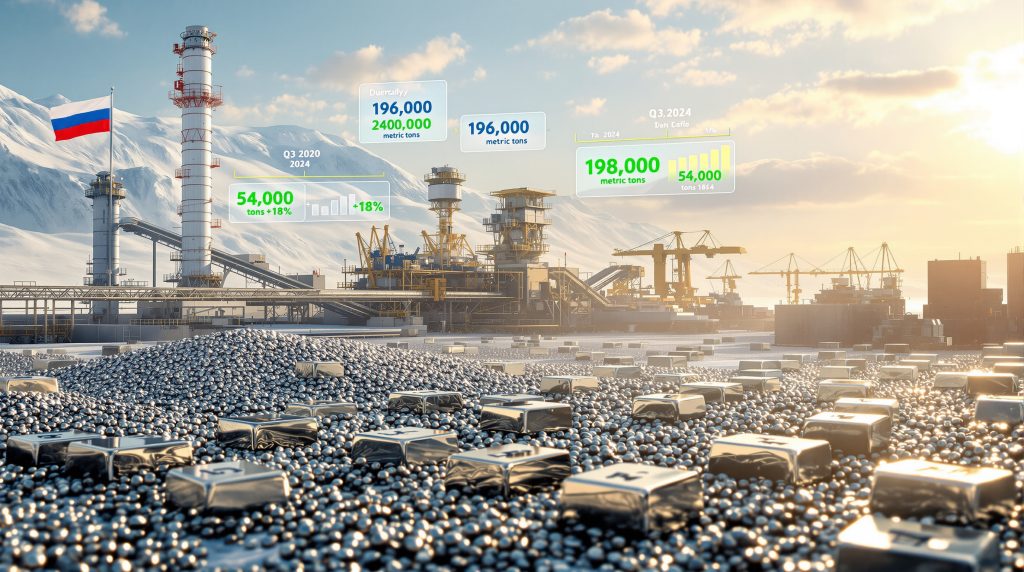Nornickel's 2025 Production Outlook Maintains Market Confidence
Russia's Nornickel has reaffirmed its Nornickel nickel production forecast for 2025, targeting 196,000 to 204,000 metric tons despite ongoing equipment modernisation challenges. This commitment demonstrates the mining giant's confidence in operational stability as global demand for battery metals continues strengthening through the critical minerals energy transition.
The maintained guidance signals strategic positioning amid equipment replacement programs affecting production volumes throughout 2024. With nickel's importance and uses serving as a critical component in electric vehicle batteries and stainless steel manufacturing, Nornickel's consistent forecasting provides market participants with supply security expectations for the coming year.
Equipment Modernisation Creates Temporary Production Adjustments
Nornickel's import substitution programme has driven temporary output variations as the company replaces Western mining equipment at its Polar Division operations. Chief Operating Officer Evgeniy Fedorov attributed production declines in the first nine months of 2024 to this gradual equipment transition, with nickel output dropping 4% year-over-year and palladium production falling 6% during the same period.
The equipment replacement initiative reflects broader geopolitical considerations affecting mining operations in Russia. Companies operating under international sanctions have increasingly focused on domestic supply chain alternatives to maintain operational continuity. This technological transition, while creating short-term production volatility, positions the company for enhanced operational independence.
Infrastructure Investment Returns Expected
Long-term capacity expansion through modernised modern mining technology systems represents a strategic investment in operational efficiency. The completion of equipment transitions should deliver improved production stability and processing capabilities compared to ageing Western-manufactured machinery requiring restricted maintenance support.
Production workflow adjustments during technology integration periods have created learning curves for operational teams. However, these temporary disruptions are expected to yield operational efficiency gains once workforce training requirements are fulfilled and new equipment systems reach optimal performance levels.
Arctic Operations Drive Quarterly Production Volatility
Third quarter 2024 demonstrated Nornickel's operational resilience, with nickel production surging 18% to 54,000 metric tons compared to the previous quarter. This recovery followed second quarter constraints when seasonal flooding at Dudinka port in the Russian Arctic restricted raw material shipments.
| Production Metric | Q2 2024 | Q3 2024 | Quarterly Change |
|---|---|---|---|
| Nickel Output | Reduced levels | 54,000 tons | +18% |
| Palladium Output | Higher baseline | 617,000 oz | -6% |
| Port Operations | Flooding disruption | Normalised | Recovered |
The production surge resulted from processing accumulated raw materials stockpiled during port disruptions. Furthermore, this inventory management approach demonstrates the company's ability to maintain operational flexibility despite Arctic logistics constraints.
Seasonal Navigation Challenges
Dudinka port experiences predictable seasonal navigation restrictions due to Arctic weather patterns. The facility's strategic location provides access to global markets but creates quarterly shipment volatility that affects both nickel and palladium output timing.
Palladium production faces greater vulnerability to logistics disruptions due to longer production cycles compared to nickel processing. The 6% quarterly decline in palladium output during Q3 2024, despite improved port conditions, illustrates these operational interdependencies between co-produced metals.
"Raw material accumulation strategies during weather-dependent shipping windows allow Nornickel to smooth production volatility across quarters, maintaining annual output targets despite seasonal constraints."
Global Nickel Market Dynamics Support Production Planning
Electric vehicle battery manufacturing continues driving long-term nickel consumption growth, with Class I nickel becoming increasingly critical for lithium-ion battery cathodes. This demand trajectory supports sustained high-capacity utilisation at integrated mining operations like Nornickel's facilities.
Stainless steel production maintains traditional nickel demand patterns, providing market stability alongside emerging battery applications. In addition, the diversified end-use portfolio reduces exposure to single-market volatility while supporting consistent production planning.
Competitive Market Positioning
Nornickel maintains its position among the world's largest nickel producers while holding the leading global market share in palladium production. This dual-metal production advantage provides operational flexibility and revenue diversification compared to single-commodity producers.
Integrated mining operations from extraction through processing deliver cost advantages relative to companies dependent on third-party facilities. Consequently, this vertical integration supports margin stability during commodity price cycles while maintaining supply chain control, as highlighted in recent mining industry innovation developments.
Geographic concentration in Russian Arctic deposits creates both advantages and risks:
- Resource quality: High-grade ore deposits with substantial reserve life
- Operational control: Complete infrastructure ownership and management
- Market access: Potential restrictions affecting customer diversification
- Logistics complexity: Arctic transportation requirements and seasonal constraints
Production Challenges Reveal Operational Complexities
Equipment transition complexities extend beyond simple machinery replacement to encompass workforce retraining, process optimisation, and supply chain coordination. Mining operations require specialised technical knowledge that cannot be rapidly transferred between different equipment manufacturers.
The gradual transition approach minimises operational disruption risks while ensuring production continuity. However, this extended timeline creates sustained production volatility until modernisation programmes reach completion across all operational divisions.
Technical Integration Requirements
New mining equipment systems require calibration with existing processing infrastructure to optimise recovery rates and operational efficiency. Integration periods involve performance testing, workflow adjustments, and quality control validation before achieving full production capacity.
Workforce training for advanced mining technologies extends beyond basic equipment operation to include preventive maintenance, troubleshooting protocols, and safety procedures specific to new machinery configurations. For instance, these competency development requirements affect production ramp-up timelines significantly.
What Are the Shared Infrastructure Dependencies?
Nickel and palladium production share critical infrastructure components including ore processing facilities, transportation networks, and port loading systems. Equipment transitions at any stage affect both metal outputs, creating production interdependencies that complicate forecasting accuracy.
Port logistics coordination becomes particularly critical given Dudinka's seasonal limitations and the requirement to ship both nickel and palladium products through the same facility. Therefore, scheduling optimisation balances inventory management with shipping window availability.
Industry Performance Comparisons
Nornickel's ability to maintain 2025 Nornickel nickel production forecast despite equipment modernisation challenges demonstrates operational resilience compared to industry peers managing similar infrastructure transitions. The company's integrated operations provide greater control over production timing compared to companies dependent on third-party processing facilities.
Production efficiency metrics during transition periods reflect management's ability to balance modernisation requirements with output consistency. The 18% quarterly recovery in Q3 2024 illustrates operational flexibility when logistics constraints are resolved.
Reserve Base Sustainability
Nornickel's substantial nickel and palladium reserves support long-term production capacity beyond current guidance periods. High-grade ore deposits in the Norilsk region provide cost advantages relative to lower-grade operations requiring higher processing volumes for equivalent metal output.
Integrated mining operations from extraction through refining create operational synergies unavailable to companies operating single-stage facilities. This vertical integration supports margin consistency across commodity price cycles while maintaining production flexibility.
Investment Implications and Market Signals
Maintained production guidance provides market participants with supply reliability indicators supporting long-term planning and investment decisions. Consistent forecasting demonstrates management confidence in operational capabilities despite short-term modernisation challenges.
The 2025 target range of 196,000 to 204,000 metric tons represents substantial global nickel supply, making production accuracy important for market balance calculations. Furthermore, supply security considerations support strategic planning for downstream consumers requiring predictable raw material availability, as detailed in Nornickel's latest metals market review.
Risk Assessment Framework
| Risk Category | Probability | Mitigation Strategy | Impact Duration |
|---|---|---|---|
| Equipment delays | Medium | Phased implementation | 6-12 months |
| Weather disruption | High | Inventory management | Quarterly |
| Market volatility | Low | Diversified end-uses | Variable |
| Geopolitical factors | Medium | Supply chain adaptation | Ongoing |
Production capacity expansion potential through completed modernisation programmes creates opportunities for volume growth beyond current guidance levels. However, expansion decisions depend on sustained market demand and geopolitical stability affecting international sales channels.
Strategic Development Priorities Through 2027
Modernisation completion benefits should enhance production stability by reducing equipment-related disruptions and improving operational predictability. Technology integration gains typically materialise 12-18 months following installation completion as operational teams optimise new system capabilities.
Cost structure optimisation through equipment efficiency improvements supports margin expansion potential once transition costs are absorbed. Modern ai-driven mining tech typically delivers improved energy efficiency, reduced maintenance requirements, and enhanced recovery rates compared to ageing predecessor systems.
Market Responsiveness Enhancement
Flexible production planning capabilities enable output adjustments based on market conditions and customer requirements. However, Arctic logistics constraints and seasonal shipping windows limit short-term production variability compared to operations with year-round transportation access.
Operational optimisation opportunities include inventory management refinement, shipping schedule coordination, and processing efficiency improvements. These incremental gains accumulate to support consistent performance against the Nornickel nickel production forecast while maintaining cost competitiveness.
Why Does 2025 Matter for Global Supply?
The maintained 2025 production guidance becomes increasingly significant as global markets navigate supply chain uncertainties. Nornickel's commitment to delivering within the forecasted range provides stability indicators for international commodity markets, as reported by industry analysts tracking Russian mining output.
Disclaimer: This analysis is based on publicly available information and contains forward-looking statements that involve inherent risks and uncertainties. Actual production results may differ from forecasts due to operational, market, or geopolitical factors beyond company control. Readers should conduct independent research before making investment decisions.
Interested in Identifying Tomorrow's Major Nickel Discovery Today?
Discovery Alert's proprietary Discovery IQ model delivers instant notifications on significant ASX mineral discoveries, transforming complex mining announcements into actionable insights for both short-term traders and long-term investors. Begin your 30-day free trial today to position yourself ahead of the market and secure your competitive advantage in identifying the next breakthrough nickel discovery.




